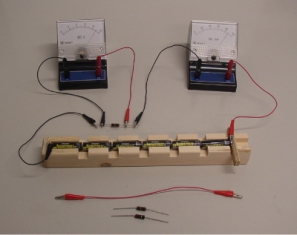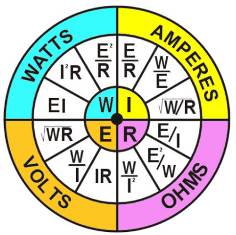The first studies of the resistance of conductors
What is a conductor? This is a purely passive component of an electrical circuit, answered the first explorers. Doing his research - means simply to rack their brains over the riddle unnecessary, because only the current source is an active element.
This way of thinking explains why the scientists, at least until 1840, almost no interest in the few works that were carried out in this direction. Thus, at the second congress of Italian scientists held in Turin in 1840 (the first was going to Pisa in 1839, and gained even some political significance), speaking in the debate on the report submitted Marianini, De la Rive argued that the conductivity of most liquids It is not absolute, "but rather relative and varies with current strength." But Ohm's law was published 15 years earlier!

Among the few scientists who were the first to engage in wire conductivity issue after the invention of the galvanometer was Stefano Marianini (1790-1866). For his discovery he came by chance, studying the battery voltage. He noted that with the increase in the number of elements voltaic pile electromagnetic influence on the arrow does not increase appreciably. It made Marianini immediately think that every volt element is an obstacle to the passage of current. He did experiments with pairs of "active" and "inactive" (ie. E. Consisting of two copper plates, separated by a wet seal) and empirically found relation in which the modern reader finds a special case of Ohm's law, when the resistance of the external circuit is not taken into attention, as it was in the experience Marianini.
 Georg Ohm (1789-1854) recognized the merits Marianini, although his work and did not have Omu immediate relief work. Ohm was inspired in his research work «La theorie analytique de la ehaleur» ( «Analytical theory of heat", Paris, 1822), Jean Baptiste Fourier (1768-1830) - one of the most important scientific works of all time, very quickly gain fame and highly appreciated among mathematicians and physicists of the time. Omu got the idea that the mechanism of "heat flux", which says Fourier, can be likened to the electric current in a conductor. And just as in the theory of the Fourier heat flow between the two bodies, or between two points of the same body is due to the difference in temperature, just as Ohm explains the difference "elektroskopicheskih forces" in the appearance of two points of the conductor of electric current between them.
Georg Ohm (1789-1854) recognized the merits Marianini, although his work and did not have Omu immediate relief work. Ohm was inspired in his research work «La theorie analytique de la ehaleur» ( «Analytical theory of heat", Paris, 1822), Jean Baptiste Fourier (1768-1830) - one of the most important scientific works of all time, very quickly gain fame and highly appreciated among mathematicians and physicists of the time. Omu got the idea that the mechanism of "heat flux", which says Fourier, can be likened to the electric current in a conductor. And just as in the theory of the Fourier heat flow between the two bodies, or between two points of the same body is due to the difference in temperature, just as Ohm explains the difference "elektroskopicheskih forces" in the appearance of two points of the conductor of electric current between them.
Adhering to this analogy, Ohm began his research with the experimental determination of the relative values of the conductivity of different conductors. Applying the method, which has now become a classic, it is connected in series between the two points of the circuit thin wires of different materials of the same diameter and change their length so as to provide a certain amount of current. The first results, which he managed to get, now seem rather modest.
Historians are affected, for example, that by measuring the Ohm silver has lower conductivity than copper and gold, and graciously accept this then by Ohm explanation, according to which the experiment was conducted with a silver wire coated with a layer of oil, and it is misleading as to the exact value diameter.
While there are many sources of error in conducting experiments (insufficient purity metals, the difficulty of calibrating the wire, the difficulty of accurate measurement and so on. N.). The most important source of the error was the polarization of the battery. The permanent (chemical) elements had not yet been known, so for the time needed for the measurement, the electromotive force of the element substantially changed. These are the causes of errors led to the fact that Om on the basis of his experiments came to the logarithmic dependence of the current strength of the resistance of a conductor connected between two points of the circuit.
Following the publication of the first article Omagh Poggendorff advised him to refuse the chemical elements and use the best thermocouple copper - bismuth, had recently introduced Seebeck. Om listened to this advice and repeated his experiments, collecting unit with the thermoelectric battery, an external circuit which comprises a sequence of eight copper wires of the same diameter but different lengths. DC Power he measured with the help of a kind of torsion balance formed by the magnetic needle, suspended on a metal filament. When the current is parallel to the direction, I reject it, Ohm twisted thread on which it was suspended until the arrow provided in its normal position; amperage considered proportional to the angle at which twists the thread.
Ohm concluded that the results of experiments carried out with eight different wires "can be expressed very well by the equation
X = a / (b + x),
where X is the intensity of the action of the magnetic conductor whose length is equal to x, and a and b - constants which depend respectively on the exciting force and the resistance of the remaining parts of the chain "
The experimental conditions were changed: replaced resistance and thermoelectric couple, but the results are still reduced to the above formula, which is very simply becomes known to us, if we replace X amperage and -elektrodvizhuschey force and (b + x) - a total resistance of the circuit.
Having this formula ohms uses it to explore the multiplier Shveyggera to deflection and to study the current that passes through the external circuit elements of the battery, depending on how they are connected - in parallel or successively. Thus he explains (as is done now in a textbook) what determines the external battery current, - a question that was pretty dark for the first researchers.

Ohm hoped that his experimental work will open the way for him to the university, which he so wished. However, the article went unnoticed. Then he left his position at the Cologne Gymnasium and went to Berlin to reflect on the results obtained theoretically. In 1827 in Berlin he published his major work «Die galvanische Kette, mathe-matisch bearbeitet» ( «Galvanic chain developed mathematically").
This theory, the development of which it was inspired, as we have already pointed out, the analytical theory of the Fourier heat, and introduces the concept of precise definition of electromotive force, or "elektroskopicheskoy force" as it is called Ohm, electrical conductivity (Starke der Leitung) and amperage. Expressing derived their law in differential form, driven by modern writers, Ohm writes it and end values for the particular cases of specific electrical circuits, of which the most important thermoelectric circuit. On this basis, it formulated the well-known laws of variation of voltage along the chain.
But Ohm's theoretical studies have also gone unnoticed, as if someone wrote about them, only to make fun of "morbid imagination, whose sole purpose is the desire to diminish the dignity of nature." It was only ten years later, his brilliant work gradually began to use the due recognition in Germany of their appreciated Poggendorff and Fechner, in Russia - Lenz, England - Wheatstone in America - Henry, Italy - Matteucci.
Along with Ohm's experiments in France carried out his experiments Becquerel, and in England - Barlow. The experience of particularly remarkable introduction of a differential galvanometer with a double winding frame and the use of "zero" measurement method. Experiments also Barlow worth mentioning because they confirmed experimentally current constancy in the chain. This conclusion was tested and distributed to the internal battery current Fechner in 1831, summed up in 1851 by Rudolf Kohlrausch (1809-1858) for liquid conductors, and again confirmed by careful experiments Nidmana Gustav (1826-1899).
Mario Letstsi "History of Physics"



Comments
Commenting, keep in mind that the content and the tone of your messages can hurt the feelings of real people, show respect and tolerance to his interlocutors, even if you do not share their opinion, your behavior in terms of freedom of speech and anonymity offered by the Internet, is changing not only virtual, but real world. All comments are hidden from the index, spam control.